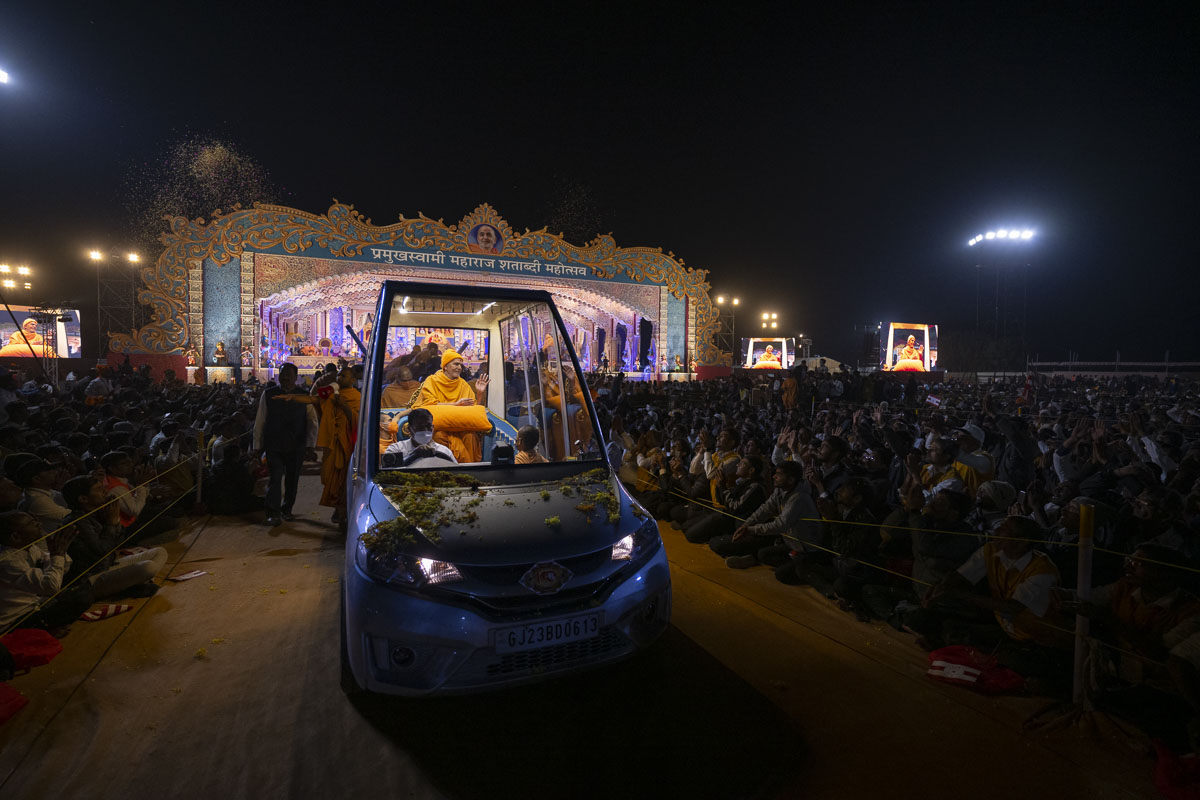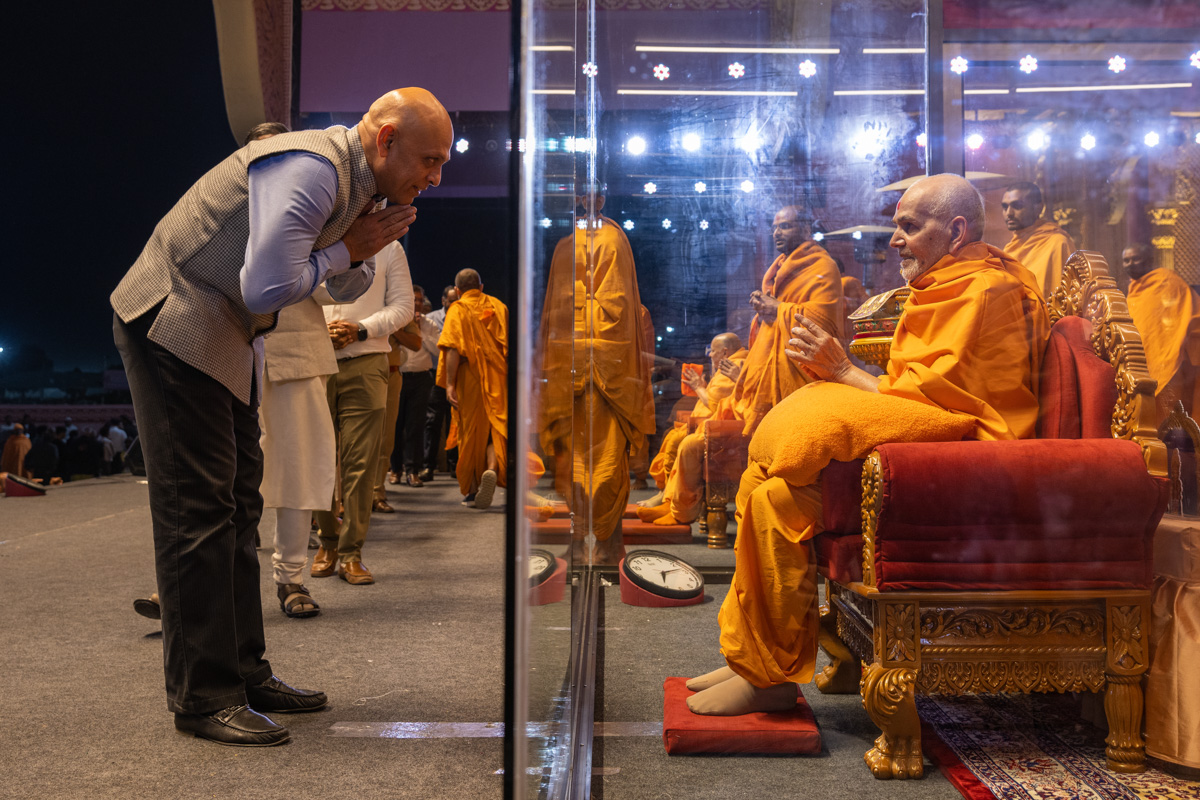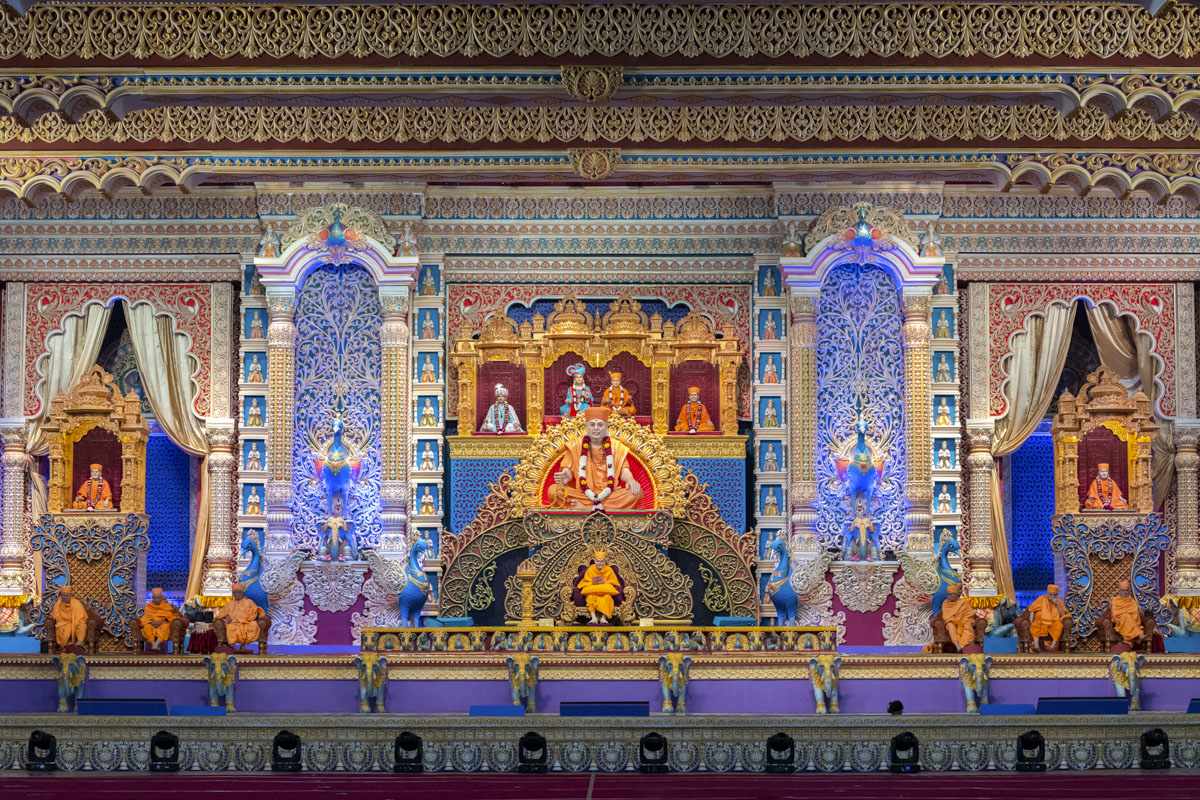Ancient Indian Texts on Temple Architecture and their Contribution to Modern Practices
19-20 December 2022, Ahmedabad, India

An international academic conference on ancient Indian temple architecture was held from 19 to 20 December 2022 at the Pramukh Swami Maharaj Nagar in Ahmedabad. The conference’s central theme was: “Ancient Indian Texts on Temple Architecture and their Contribution to Modern Practices.” The conference was organized by BAPS Swaminarayan Research Institute in collaboration with Indira Gandhi National Centre for the Arts (IGNCA), a premier research institute of the Indian Government’s Ministry of Culture, as part of the centenary celebrations of His Holiness Pramukh Swami Maharaj.
Eminent scholars from around the world presented original research at this two-day conference. The conference explored the role of temples (mandirs) as sacred spaces of devotion and cultural expression. The impact of temples in cultivating moral formation, social harmony, and community service was also highlighted. Researchers showcased the relationship between modern temple architectural practices and ancient texts on temple-building and investigated its development. The conference also celebrated Pramukh Swami Maharaj’s contribution to the legacy of temple-building and the profound impact it continues to play in communities across the world.
The conference witnessed a rich blend of both young and senior scholars from universities worldwide, including prominent institutions in New Delhi, Cambridge, Harvard, Chicago, and Toronto. They presented original research from various disciplinary perspectives, including philosophy, sociology, literature, and history.
The Inaugural Session
The conference commenced with an inaugural session during which Pujya Viveksagardas Swami consecrated the International Conference by performing deep pragatya in the presence of Pujya Anandswarupdas Swami, Brahmviharidas Swami, Shrutiprakashdas Swami, Bhadreshdas Swami, Aksharvatsaldas Swami, and other delegates. Dr. Sachchidanand Joshi, the Executive and Academic Head of the IGNCA; Shri D. N. V. Prasad Sthapathy, the chief architect of the Statue of Equality; Prof. G. B. Deglurkar, the former Vice-Chancellor of the Deccan College; Shri Divya Kush, the former president of the Indian Institute of Architects; and Shri Jitendra Shah, the former director of L. D. Institute of Indology–all joined in the ritual ceremony.
Thereafter, Brahmviharidas Swami delivered a welcome address to more than 150 scholars and delegates. He encouraged the attendees to approach this conference with a progressive mindset, not just to learn about history, but to create it. Pramukh Swami Maharaj worked to preserve the core values of humanity through building temples and bringing society together. Citing the example of the BAPS Hindu Mandir being created in Abu Dhabi, he explained how mandirs serve to synergize cultures, preserve traditional values, and integrate contemporary technological advancements.
Dr. Sachchidanand Joshi, thereafter, elaborated on the conference’s central theme by explaining the significance of manuscripts in preserving heritage. In this light, he identified Pramukh Swami Maharaj as a visionary, stating, “Pramukh Swami Maharaj was not just a man of thought, but also a man of action. We cannot even remember the names of 1200 temples, let alone make them.” In his keynote address, Dr. Shri Krishna Jugnu, an acclaimed scholar of ancient Indian architectural texts, highlighted the rich architectural heritage of India. He explained the significance of the Agamas, Samhitas, Shilpa Shastras, Puranas, and other sacred texts and their role in shaping culture, art, architecture, and spiritual practices through the ages.
The Plenary Session
After the inaugural session, the plenary session featured distinguished scholars who highlighted specific aspects of temple architecture. In his opening address, Shri Snehal Shah, a renowned Indian architect, showcased the adaptation of the Maru-Gurjara style of architecture in the context of M. A. Dhaky’s works. Shri Yatin Pandya, a well-known researcher, architect, and the founder of Footprints EARTH, focussed on the spatial and spiritual significance of temples. He explained how temples foster an environment where an individual can withdraw from the worldly realm and experience an intimate and personal connection with the divine. He further added that temples represent a space for the culmination and synchronization of all aspects of life–including dance, music, and poetry.
Thereafter, Shri Kiran Trivedi explained the significance of modern technological advancements in helping enhance the temple architectural tradition. Shri Vinod Kumar, the director of DD Architects, elaborated on the ‘living’ aspects of a temple in the context of Kerala temple architecture. He also expanded on the importance of sustaining regional rituals and crafts to conserve the living temples of Kerala.
Thereafter, Shri Snehal Patel, an engineer with practical experience in temple creation, explained the concepts of structural engineering used in the construction of the BAPS Hindu Temple in Abu Dhabi, UAE. Shri Sanjay Parikh, whose technical experience in constructing temples spans over three decades, explained how the construction of BAPS Swaminarayan mandirs is rooted in the engineering principles of ancient Indian texts like Shilpa Shastra.
The plenary session was concluded by Prof. G. B. Deglurkar, the former Vice-Chancellor of the Deccan College. In his presentation on the Maharashtra temples, he identified temples as encoded constructions that required interpretive skills like iconography and iconology to decipher their hidden meaning and significance. Citing The Hindu Temple by Stella Kramrisch, he noted that even the smallest part of a temple has meaning and purpose. As an example, he stated that details like the darpans (mirrors) at the Swaminarayan Akshardham, New Delhi, serve to encourage self-reflection.
The Presentation Sessions
After the plenary sessions, the delegates presented their research in parallel sessions which ran throughout the day. Shri Pratapanand Jha, who chaired one of the sessions, explored the case study of Thanjavur Brihadeeswara Temple and highlighted the role of the IGNCA in conserving ancient Indian temples through technological advancements. Dr. Sudhir Lall, a senior faculty and project director at IGNCA, explained the significance of time and space in performing rituals. He also acknowledged the role of Pramukh Swami Maharaj’s Centenary Celebrations in preserving the yajna tradition.
Conference – Day 2
In his opening address of the following day’s first session, Shri D. N. V. Prasad Sthapathy acknowledged Pramukh Swami Maharaj’s decisive role in representing Indian traditions and cultural values by creating temples throughout five continents. He also expressed his gratitude to Mahant Swami Maharaj for his involvement in the inauguration of Ramanujacharya’s murti, also known as the Statue of Equality. Thereafter, Shri Divya Kush recognized the importance of vastu in practicing modern architecture and the relationship between nature and art in shaping architecture. Shri Anand Ukidve then presented the journey from ancient Indian architecture to the extraordinary replica of Swaminarayan Akshardham currently displayed at the Pramukh Swami Maharaj Nagar, Ahmedabad. Dr. Shonaleeka Kaul, an Associate Professor at Jawaharlal Nehru University, recognized the significance of the Indian temple architecture as not just a confined place, but rather a universal and encompassing space. A parallel session was also conducted and chaired by Shri Rabindra Vasavada.
The following session was chaired by Shri Jitendra Shah. During this session, Dr. Shrutiprakashdas Swami, a renowned Sanskrit scholar and the Director of AARSH, Gandhinagar, highlighted Swaminarayan Akshardham’s (New Delhi) comprehensive expression of ancient Indian scripturality by including the chaturvyuh (24 unique) murtis. He further explained how this architectural presentation of religious tradition furthered the intellectual revelations of Bhagwan Swaminarayan.
Padma Shri Prabhakar Maharana, a well-known sculptor from Orissa, thereafter, praised the efforts of BAPS sadhus, particularly Shrutiprakashdas Swami, in examining the connection between ancient Indian texts and modern temples and adhering to them when creating BAPS mandirs. He then elaborated on the significant role of religious artisans in integrating ancient Indian architectural principles through temples right from the 8th century CE.
Shri Jitendra Shah concluded the session by acknowledging the pioneering contributions of the Swaminarayan tradition in constructing temples and identified the BAPS Swaminarayan Akshardham at Robbinsville as one of the most awaited creations. By drawing parallels between mandir creation guidelines described within ancient texts and spiritual practices involved in mandir creation practices, he recognized Pramukh Swami Maharaj’s contributions to the temple-building tradition as profound expressions of dedication and devotion.
In the concluding session of this International Conference, Prof. G. B. Deglurkar remarked, “I have not seen such a well-organized event elsewhere. Everyone here works selflessly—without asking for anything in return and without expectations.” Regarding the Pramukh Swami Maharaj Nagar, he noted, “The ambience is both magnificent and divine. It cannot be human-made, but only divinely inspired.” Prof. G. B. Deglurkar further explained, “He (Pramukh Swami Maharaj) has given new life to Hinduism… Pramukh Swami Maharaj’s inspired creation of over 1100 temples is a wonder. Yesterday, Shri Y. S. Rajan stated that with the blessings of Swamiji, one day a temple will be created on the moon. I remarked that the BAPS Hindu temple being constructed in Abu Dhabi is itself a temple on the moon.” He finally emphasized the significance of temples in preserving a 7000-year old Indian tradition. Shri Yatin Pandya also remarked that “the legacy of Pramukh Swami Maharaj is not a fossilized history, it is a living history.” Thereafter, Akshaymunidas Swami, who has been contributing to the creation of BAPS mandirs around the world for more than five decades, felicitated Shri Rabindra Vasavada, Shri Yatin Pandya, Shri Jitendra Shah, Shri Chandrakant Sompura, Shri Virendra Sompura, Shri Devdutt Sompura, and Shri Chetan Sompura.
Finally, Dr. Jyotindra Dave expressed his gratitude to the organizers of the conference, particularly Dr. Sachchidanand Joshi, Shri Pratapanand Jha, and Aksharvatsaldas Swami. He also thanked Prof. G. B. Deglurkar, Shri Rabindra Vasavada, Dr. Krishna Jugnu, Shri Jitendra Shah, Shri Yatin Pandya, and all the participants and volunteers for their valuable contributions.
Dignitaries attending the conference expressed gratitude for being given the opportunity to collaborate, discuss, and share their insights. New scholars and students also appreciated the experience of learning, exploring, and contributing to the field of study, as the conference allowed them to expand their knowledge and skills and make meaningful contributions to the academic community. Many delegates also felt that the Pramukh Swami Maharaj Nagar was a fitting location for the conference as it exemplified the magnificence of Indian cultural values and presented architectural traditions in a modern context. This conference not only became an excellent platform for sharing incisive academic insights but also offered a tribute to the life, work, and message of His Holiness Pramukh Swami Maharaj—the unprecedented master-builder of our times.







